Pine Bunting is widespread in Siberia as a breeding bird of open pine forest west to the Urals, where its breeding range just spills into the European foothills. It generally migrates further south across Asia in the non-breeding season, but in the Western Palearctic it has also traditionally been regarded as a regular if localised winter visitor to northern Israel, a scarcer winterer in Italy (mainly Tuscany) and rarer still in southern France. Elsewhere in Europe, it is only a rare vagrant, with a tendency to show up during the winter months. Males are an irrefutably fetching bird and don't particularly recall the species' much more familiar relative, Yellowhammer, but use the mind's eye to paint Pine Bunting's white areas yellow and the relationship becomes clearer. The close association between the two taxa grows ever starker if one compares recordings of the song. Pine Buntings and Yellowhammers are apparently quite open to a bit of the other as there is a strong tendency for the two to hybridise; this occurs over a broad zone where they are sympatric. Such hybrids are not only another reminder of the buntings' taxonomic intimacy, but have provided Europe with some interesting vagrant individuals over the years, some of which have proved easier to resolve than others.
Identification
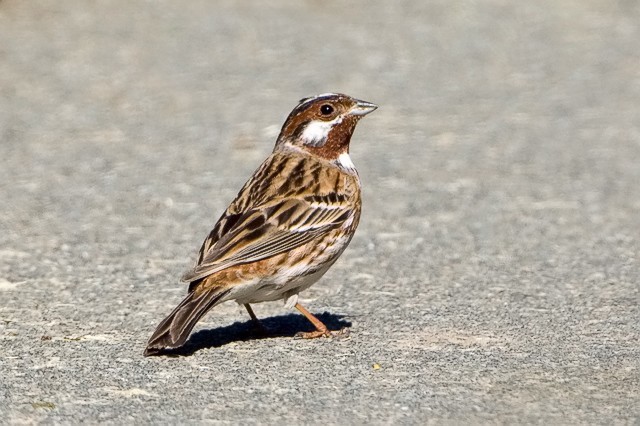
Summer male Pine Bunting, Guernsey (Photo: Paul Hillion)
Pine Bunting is a crisp-looking bird, with absolute white underpart ground colour as well as whitish edges to the outer webs of the primaries. The lesser coverts are grey, contrasting (together with the greyish back) against the warm scapular tones, and the bill is often strikingly bicoloured. A breeding-plumaged male Pine Bunting has an eye-catching face pattern with bold white ear coverts and central crown both framed by a thick, neat, black surround. The supercilium and throat are reddish-brown; there is a sharp border between the latter and a neat white spot on the upper breast. Just below this spot, the streaking is blacker than in Yellowhammer, this developing into a reddish-brown colour lower down and on the flanks, where the colour bleeds out into the white underparts. In winter males, the throat and supercilium appear darker and less reddish, while the white areas on the head are also dulled down.
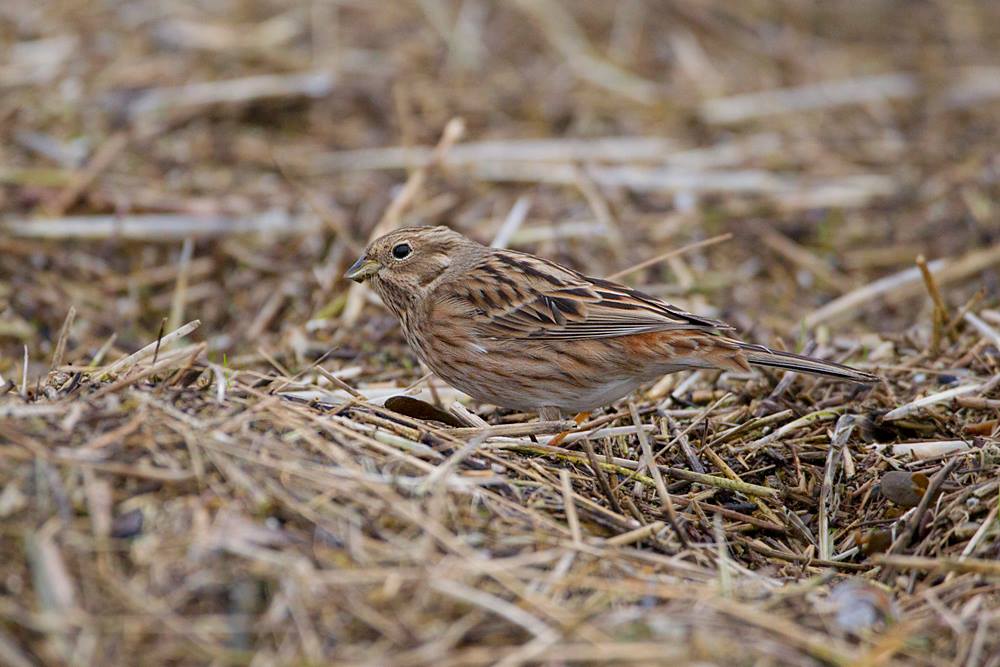
Female Pine Bunting, Netherlands (Photo: David Monticelli)
Females superficially resemble a very clean, greyish Yellowhammer but additional critical features include sharply defined streaking on both the crown (where more restricted to the sides of the crown, producing a vague impression of a central crown stripe) and the flanks, a pale area on the nape and deeper rufous tones to the scapulars than Yellowhammers exhibit. In comparison with Yellowhammers of the same sex, female Pine Buntings have a supercilium which is both subtly broader and bolder, as well as better matching the colour of the lores while contrasting strongly with the ear-coverts and the sides of the crown. The white eyering is also slightly better defined, while the grey areas around the neck are not so clean as in Yellowhammer, nor is the throat. Both the moustachial and malar strips are stronger and the blackish streaking on the upper breast is important.
Hybrids fortunately often display a tell-tale mix of features which are readily detected given adequate views, and a familiarity with the identification of both species should stand any birder in good stead for tackling a potential intermediate. However, some individuals are more troublesome as clashing visible features become ever more diluted in descendants of the original hybrids themselves. In obvious birds, the head pattern is usually the first giveaway, and hybrids frequently appear as 'white-headed' or 'yellow-headed' variations. In any potential Pine Bunting, the bird's entire plumage must be scrutinised for any residual yellow tones which might betray a tainted pedigree. The fringes of the primaries are perhaps the best place to look as this is often the last place where yellow is shown in more troublesome hybrids and backcrosses, but it has been known for birds with no other suggestion of Yellowhammer genes to exhibit conflicting colour only in the underwing coverts or at the concealed bases of the crown feathers.
History in the Western Palearctic
Pine Bunting was a minor, yet familiar, component of Italy's avifauna during the 20th century, with the species described as an 'uncommon' migrant and winter visitor, detected most frequently in northern provinces and, sadly, often via a hunter's mistnet. Before the early 1970s, the species featured in city bird markets from time to time. Italian records tailed off considerably thereafter in line with a dwindling trade in passerines, until 1995 when an area of dunes near the River Serchio mouth in Tuscany was suddenly found to be supporting as many as 50 wintering individuals.
By 2001, two further wintering sites were unearthed along the coast of Tuscany, where birds would arrive around the first week of November and linger until early March. Regular winter sightings fizzled out by the mid–-000s, although small numbers are still occasionally found elsewhere in northern Italy in winter — for example, up to five wintered annually near Maserada sul Piave, Veneto, until at least winter 2011/12 and two were seen in Piedmont as recently as January 2015. The preferred wintering habitat in Tuscany is relatively flat coastal dunes, extensive in length but narrow and with pine trees in the vicinity, the closest possible match to habitats used in Siberian breeding grounds.
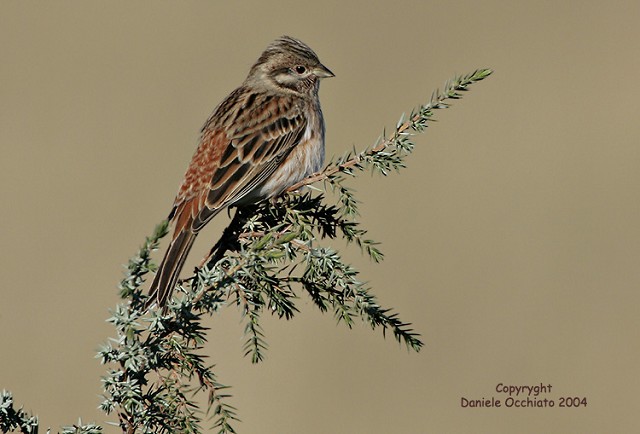
Male Pine Bunting, Tuscany, Italy (Photo: Daniele Occhiato)
Carmargue, France, was once another prime European wintering area for Pine Bunting at this time. Arles held birds on numerous occasions between January 1997 (when there was a peak count of eight birds) and February 2007, although this regular flock has since disappeared and the species has now regained its former status as a very rare vagrant in the country.
The Western Palearctic's wintering stronghold for Pine Bunting was traditionally Israel. It has always been scarce and localised here but in the 1980s and 1990s there were several wintering populations, usually numbering in to the tens, but in some years up to a few hundred could be found at Mount Hermon. Since this peak, numbers have declined considerably. While still seen every winter, traditional sites now hold no more than single figures, though much of Mount Hermon is now off-limits (due to security issues) and it is possible that more may persist there. There are also records from Syria and, in recent years, Azerbaijan, though the former is now a no-go zone and the latter is so scantily explored that the species is likely vastly under-recorded there.
Elsewhere, Pine Bunting remains a rare vagrant, although it may well be under-recorded in some of the more sparsely-birded countries of southern, central and eastern Europe. For example, the presence of a flock of 12 birds in Cyprus' Troodos Mountains in December 2003 was just the fifth record for the island, and two together in Romania in April 2008 represented the first national occurrence. Despite the downward trend in recent years, most winters also usually produce one or two isolated vagrants in northern and western Europe — winter 2014/5 has so far produced at least one in Limburg, Netherlands, and a male in Niedersachsen, Germany.
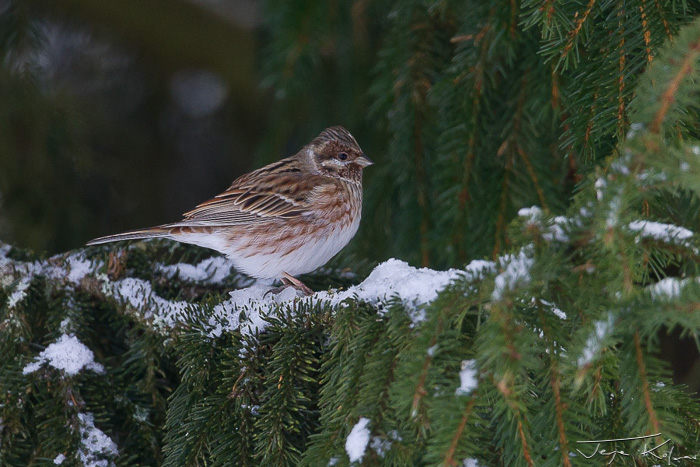
Male Pine Bunting, Norway (Photo: Terje Kolaas)
There have been 50 British records of Pine Bunting, with Fair Isle laying claim to the first in 1911, and a further two from Ireland. It remained a major rarity and very much infrequent until the mid–-980s, with four records in 1987, and a strong run continuing until just before the millennium, with only two blank years between 1987 and 1998, and all other years but 1989 serving multiple occurrences. It seems that a turning point was reached and Pine Bunting became rare again around 2005, a year in which three turned up in Britain, but subsequently it has slipped considerably from the rarity-finder's line of sight. Most birds have occurred in October (19 records) and November (9), with each month from January through to April having between four and seven records to its name. The total of five records in 1995 seems almost unthinkable now.
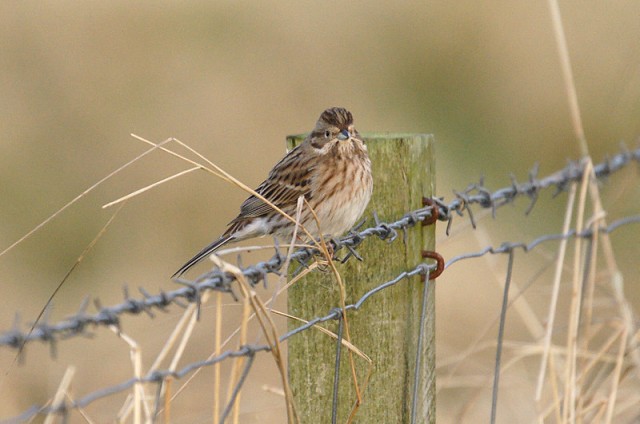
First-winter female Pine Bunting, Unst, Shetland (Photo: Mike Pennington)
Population trends for Pine Bunting are poorly understood but there are no glaring indications that it is in decline, nor a clear explanation for the fall in the numbers that Europe has experienced over recent years. What is certain is that the species has become notoriously difficult to connect with in Britain over the past decade and it can now unequivocally be said to have regained its status as a true mega, manifesting only as a gap in the lists of almost every member of the new generation of birders. There have only been three records since 2005, none bearing that crucial combination of being both accessible and long staying. This reflects a wider decline in winter occurrences across the Western Palearctic, which may well suggest a population decline in the west of the species' breeding range, but could also be explained by a shift in Pine Bunting's wintering range. It may be that this is never truly understood — observer coverage across great swathes of eastern Europe, the Middle East and Central Asia remains much lower than corresponding areas in western and northern Europe.
Sadly, Yellowhammers themselves are a far less abundant sight in the British countryside than they once were, but sizeable winter flocks do still gather in some areas and these are perhaps the best place to look for a stray Pine Bunting. This is one rarity which has the full potential to turn up at an apparently uninspiring inland site during the quieter winter months, and it might be worth investing effort to study any bunting flock you are fortunate enough to come across.
The identification of Pine Bunting in relation to Yellowhammer and Cirl Bunting is covered in more detail in the January 2016 issue of Birdwatch (283: 39–43). Bird News Extra subscribers can also view full details of all British and Irish records of Pine Bunting here.
Acknowledgements
Many thanks to Daniele Occhiato (Italy), Yoav Perlman (Israel) and Pierre-André Crochet (France) for their help and information on the status of Pine Buntings.


